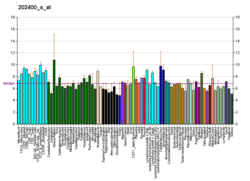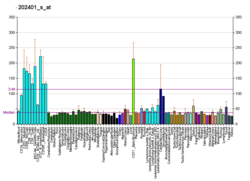Serum response factor, also known as SRF, is a transcription factor protein.[5]
Function
[edit]Serum response factor is a member of the MADS (MCM1, Agamous, Deficiens, and SRF) box superfamily of transcription factors.[6] This protein binds to the serum response element (SRE) in the promoter region of target genes. This protein regulates the activity of many immediate early genes, for example c-fos, and thereby participates in cell cycle regulation, apoptosis, cell growth, and cell differentiation. This gene is the downstream target of many pathways; for example, the mitogen-activated protein kinase pathway (MAPK) that acts through the ternary complex factors (TCFs).[7][8]
SRF is important during the development of the embryo, as it has been linked to the formation of mesoderm.[9][10] In the fully developed mammal, SRF is crucial for the growth of skeletal muscle.[11] Interaction of SRF with other proteins, such as steroid hormone receptors, may contribute to regulation of muscle growth by steroids.[12] Interaction of SRF with other proteins such as myocardin or Elk-1 may enhance or suppress expression of genes important for growth of vascular smooth muscle.
Clinical significance
[edit]Lack of skin SRF is associated with psoriasis and other skin diseases.[13]
Interactions
[edit]Serum response factor has been shown to interact with:
See also
[edit]References
[edit]- ^ a b c GRCh38: Ensembl release 89: ENSG00000112658 – Ensembl, May 2017
- ^ a b c GRCm38: Ensembl release 89: ENSMUSG00000015605 – Ensembl, May 2017
- ^ "Human PubMed Reference:". National Center for Biotechnology Information, U.S. National Library of Medicine.
- ^ "Mouse PubMed Reference:". National Center for Biotechnology Information, U.S. National Library of Medicine.
- ^ Norman C, Runswick M, Pollock R, Treisman R (December 1988). "Isolation and properties of cDNA clones encoding SRF, a transcription factor that binds to the c-fos serum response element". Cell. 55 (6): 989–1003. doi:10.1016/0092-8674(88)90244-9. PMID 3203386. S2CID 20004673.
- ^ Shore P, Sharrocks AD (April 1995). "The MADS-box family of transcription factors". Eur. J. Biochem. 229 (1): 1–13. doi:10.1111/j.1432-1033.1995.0001l.x. PMID 7744019.
- ^ Dalton S, Marais R, Wynne J, Treisman R (June 1993). "Isolation and characterization of SRF accessory proteins". Philos. Trans. R. Soc. Lond. B Biol. Sci. 340 (1293): 325–32. Bibcode:1993RSPTB.340..325D. doi:10.1098/rstb.1993.0074. PMID 8103935.
- ^ "SRF serum response factor". Entrez Gene. National Center for Biotechnology Information, National Institutes of Health.
- ^ Sepulveda JL, Vlahopoulos S, Iyer D, Belaguli N, Schwartz RJ (July 2002). "Combinatorial expression of GATA4, Nkx2-5, and serum response factor directs early cardiac gene activity". J. Biol. Chem. 277 (28): 25775–82. doi:10.1074/jbc.M203122200. PMID 11983708.
- ^ Barron MR, Belaguli NS, Zhang SX, Trinh M, Iyer D, Merlo X, Lough JW, Parmacek MS, Bruneau BG, Schwartz RJ (March 2005). "Serum response factor, an enriched cardiac mesoderm obligatory factor, is a downstream gene target for Tbx genes". J. Biol. Chem. 280 (12): 11816–28. doi:10.1074/jbc.M412408200. PMID 15591049.
- ^ Li S, Czubryt MP, McAnally J, Bassel-Duby R, Richardson JA, Wiebel FF, Nordheim A, Olson EN (January 2005). "Requirement for serum response factor for skeletal muscle growth and maturation revealed by tissue-specific gene deletion in mice". Proc. Natl. Acad. Sci. U.S.A. 102 (4): 1082–7. Bibcode:2005PNAS..102.1082L. doi:10.1073/pnas.0409103102. PMC 545866. PMID 15647354.
- ^ Vlahopoulos S, Zimmer WE, Jenster G, Belaguli NS, Balk SP, Brinkmann AO, Lanz RB, Zoumpourlis VC, Schwartz RJ (March 2005). "Recruitment of the androgen receptor via serum response factor facilitates expression of a myogenic gene". J. Biol. Chem. 280 (9): 7786–92. doi:10.1074/jbc.M413992200. PMID 15623502.
- ^ Koegel H, von Tobel L, Schäfer M, Alberti S, Kremmer E, Mauch C, Hohl D, Wang XJ, Beer HD, Bloch W, Nordheim A, Werner S (April 2009). "Loss of serum response factor in keratinocytes results in hyperproliferative skin disease in mice". J. Clin. Invest. 119 (4): 899–910. doi:10.1172/JCI37771. PMC 2662566. PMID 19307725.
- ^ Jung DJ, Sung HS, Goo YW, Lee HM, Park OK, Jung SY, Lim J, Kim HJ, Lee SK, Kim TS, Lee JW, Lee YC (July 2002). "Novel transcription coactivator complex containing activating signal cointegrator 1". Mol. Cell. Biol. 22 (14): 5203–11. doi:10.1128/mcb.22.14.5203-5211.2002. PMC 139772. PMID 12077347.
- ^ a b Zhu C, Johansen FE, Prywes R (September 1997). "Interaction of ATF6 and serum response factor". Mol. Cell. Biol. 17 (9): 4957–66. doi:10.1128/MCB.17.9.4957. PMC 232347. PMID 9271374.
- ^ Hanlon M, Sealy L (May 1999). "Ras regulates the association of serum response factor and CCAAT/enhancer-binding protein beta". J. Biol. Chem. 274 (20): 14224–8. doi:10.1074/jbc.274.20.14224. PMID 10318842.
- ^ Sealy L, Malone D, Pawlak M (March 1997). "Regulation of the cfos serum response element by C/EBPbeta". Mol. Cell. Biol. 17 (3): 1744–55. doi:10.1128/mcb.17.3.1744. PMC 231899. PMID 9032301.
- ^ a b Matsuzaki K, Minami T, Tojo M, Honda Y, Saitoh N, Nagahiro S, Saya H, Nakao M (March 2003). "PML-nuclear bodies are involved in cellular serum response". Genes Cells. 8 (3): 275–86. doi:10.1046/j.1365-2443.2003.00632.x. PMID 12622724. S2CID 9697837.
- ^ Hassler M, Richmond TJ (June 2001). "The B-box dominates SAP-1-SRF interactions in the structure of the ternary complex". EMBO J. 20 (12): 3018–28. doi:10.1093/emboj/20.12.3018. PMC 150215. PMID 11406578.
- ^ Belaguli NS, Sepulveda JL, Nigam V, Charron F, Nemer M, Schwartz RJ (October 2000). "Cardiac tissue enriched factors serum response factor and GATA-4 are mutual coregulators". Mol. Cell. Biol. 20 (20): 7550–8. doi:10.1128/mcb.20.20.7550-7558.2000. PMC 86307. PMID 11003651.
- ^ Morin S, Paradis P, Aries A, Nemer M (February 2001). "Serum response factor-GATA ternary complex required for nuclear signaling by a G-protein-coupled receptor". Mol. Cell. Biol. 21 (4): 1036–44. doi:10.1128/MCB.21.4.1036-1044.2001. PMC 99558. PMID 11158291.
- ^ Joliot V, Demma M, Prywes R (February 1995). "Interaction with RAP74 subunit of TFIIF is required for transcriptional activation by serum response factor". Nature. 373 (6515): 632–5. Bibcode:1995Natur.373..632J. doi:10.1038/373632a0. PMID 7854423. S2CID 47196160.
- ^ Zhu H, Joliot V, Prywes R (February 1994). "Role of transcription factor TFIIF in serum response factor-activated transcription". J. Biol. Chem. 269 (5): 3489–97. doi:10.1016/S0021-9258(17)41889-8. PMID 8106390.
- ^ Grueneberg DA, Henry RW, Brauer A, Novina CD, Cheriyath V, Roy AL, Gilman M (October 1997). "A multifunctional DNA-binding protein that promotes the formation of serum response factor/homeodomain complexes: identity to TFII-I". Genes Dev. 11 (19): 2482–93. doi:10.1101/gad.11.19.2482. PMC 316568. PMID 9334314.
- ^ Kim DW, Cheriyath V, Roy AL, Cochran BH (June 1998). "TFII-I enhances activation of the c-fos promoter through interactions with upstream elements". Mol. Cell. Biol. 18 (6): 3310–20. doi:10.1128/mcb.18.6.3310. PMC 108912. PMID 9584171.
- ^ Groisman R, Masutani H, Leibovitch MP, Robin P, Soudant I, Trouche D, Harel-Bellan A (March 1996). "Physical interaction between the mitogen-responsive serum response factor and myogenic basic-helix-loop-helix proteins". J. Biol. Chem. 271 (9): 5258–64. doi:10.1074/jbc.271.9.5258. PMID 8617811.
- ^ Biesiada E, Hamamori Y, Kedes L, Sartorelli V (April 1999). "Myogenic basic helix-loop-helix proteins and Sp1 interact as components of a multiprotein transcriptional complex required for activity of the human cardiac alpha-actin promoter". Mol. Cell. Biol. 19 (4): 2577–84. doi:10.1128/MCB.19.4.2577. PMC 84050. PMID 10082523.
- ^ Yamada K, Osawa H, Granner DK (October 1999). "Identification of proteins that interact with NF-YA". FEBS Lett. 460 (1): 41–5. Bibcode:1999FEBSL.460...41Y. doi:10.1016/s0014-5793(99)01311-3. PMID 10571058. S2CID 28576187.
- ^ Lee SK, Kim JH, Lee YC, Cheong J, Lee JW (April 2000). "Silencing mediator of retinoic acid and thyroid hormone receptors, as a novel transcriptional corepressor molecule of activating protein-1, nuclear factor-kappaB, and serum response factor". J. Biol. Chem. 275 (17): 12470–4. doi:10.1074/jbc.275.17.12470. PMID 10777532.
- ^ Kim HJ, Kim JH, Lee JW (October 1998). "Steroid receptor coactivator-1 interacts with serum response factor and coactivates serum response element-mediated transactivations". J. Biol. Chem. 273 (44): 28564–7. doi:10.1074/jbc.273.44.28564. PMID 9786846.
- ^ Gupta M, Kogut P, Davis FJ, Belaguli NS, Schwartz RJ, Gupta MP (March 2001). "Physical interaction between the MADS box of serum response factor and the TEA/ATTS DNA-binding domain of transcription enhancer factor-1". J. Biol. Chem. 276 (13): 10413–22. doi:10.1074/jbc.M008625200. PMID 11136726.
Further reading
[edit]- Esnault C, Stewart A, Gualdrini F, East P, Horswell S, Matthews N, Treisman R (May 2014). "Rho-actin signaling to the MRTF coactivators dominates the immediate transcriptional response to serum in fibroblasts". Genes & Development. 28 (9): 943–58. doi:10.1101/gad.239327.114. PMC 4018493. PMID 24732378.
- Huh S, Song HR, Jeong GR, Jang H, Seo NH, Lee JH, Lee TH (Feb 2018). "Suppression of the ERK–SRF axis facilitates somatic cell reprogramming". Experimental & Molecular Medicine. 50 (2): e448. doi:10.1038/emm.2017.279. PMC 5903827. PMID 29472703.
- Pellegrino R, Thavamani A, Calvisi DF, Budczies J, Neumann A, Geffers R, et al. (January 2021). "Serum Response Factor (SRF) Drives the Transcriptional Upregulation of the MDM4 Oncogene in HCC". Cancers. 13 (2): 199. doi:10.3390/cancers13020199. PMC 7829828. PMID 33429878.
- Hu X, Wu Q, Zhang J, Kim J, Chen X, Hartman AA, et al. (January 2021). "Reprogramming progressive cells display low CAG promoter activity". Stem Cells. 39 (1): 43–54. doi:10.1002/stem.3295. PMC 7821215. PMID 33075202.
- Kepser LJ, Khudayberdiev S, Hinojosa LS, Macchi C, Ruscica M, Marcello E, et al. (February 2021). "Cyclase-associated protein 2 (CAP2) controls MRTF-A localization and SRF activity in mouse embryonic fibroblasts". Scientific Reports. 11 (1): 4789. Bibcode:2021NatSR..11.4789K. doi:10.1038/s41598-021-84213-w. PMC 7910472. PMID 33637797.
External links
[edit]- Serum+Response+Factor at the U.S. National Library of Medicine Medical Subject Headings (MeSH)
- FactorBook SRF
This article incorporates text from the United States National Library of Medicine ([1]), which is in the public domain.









